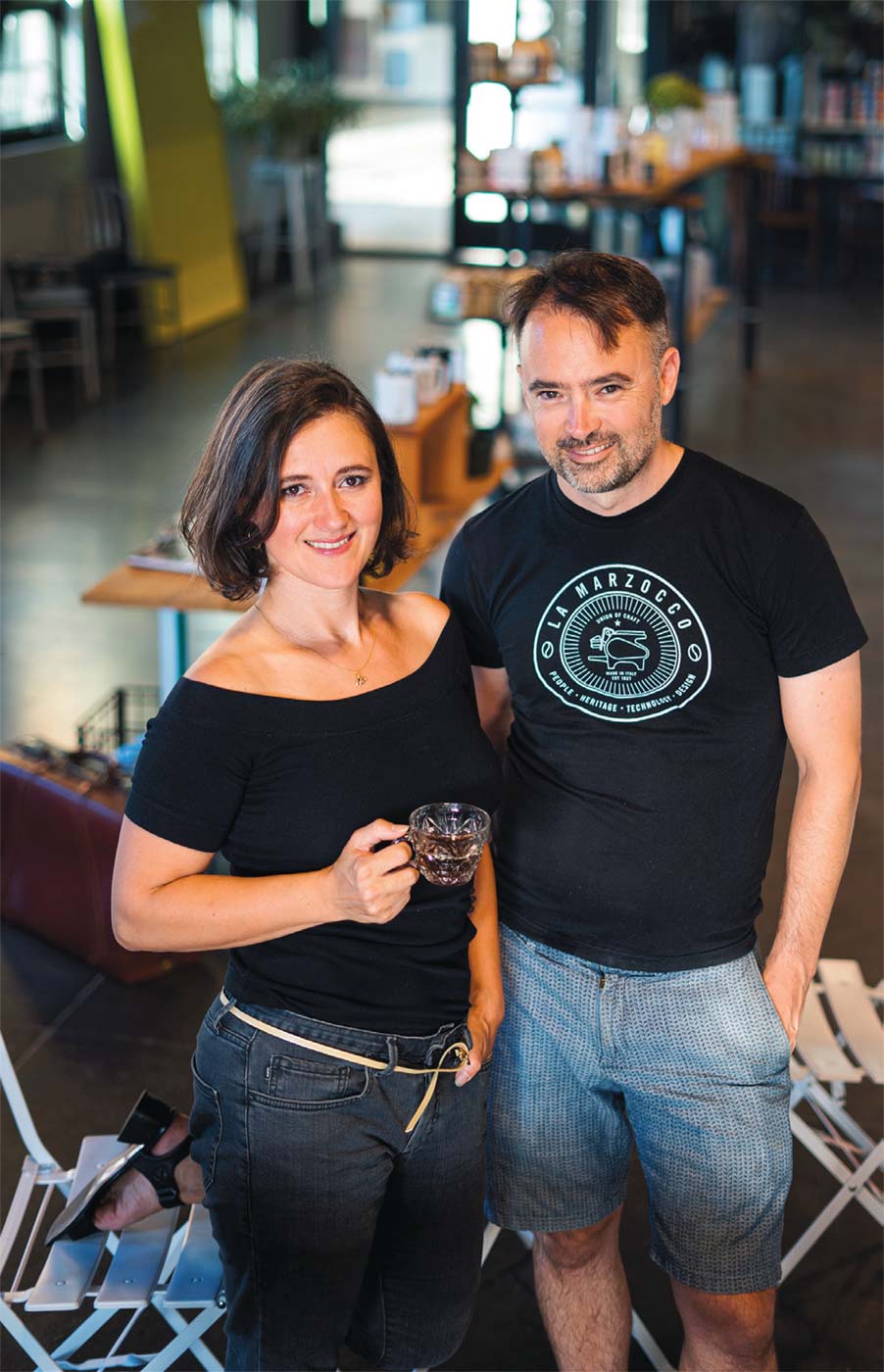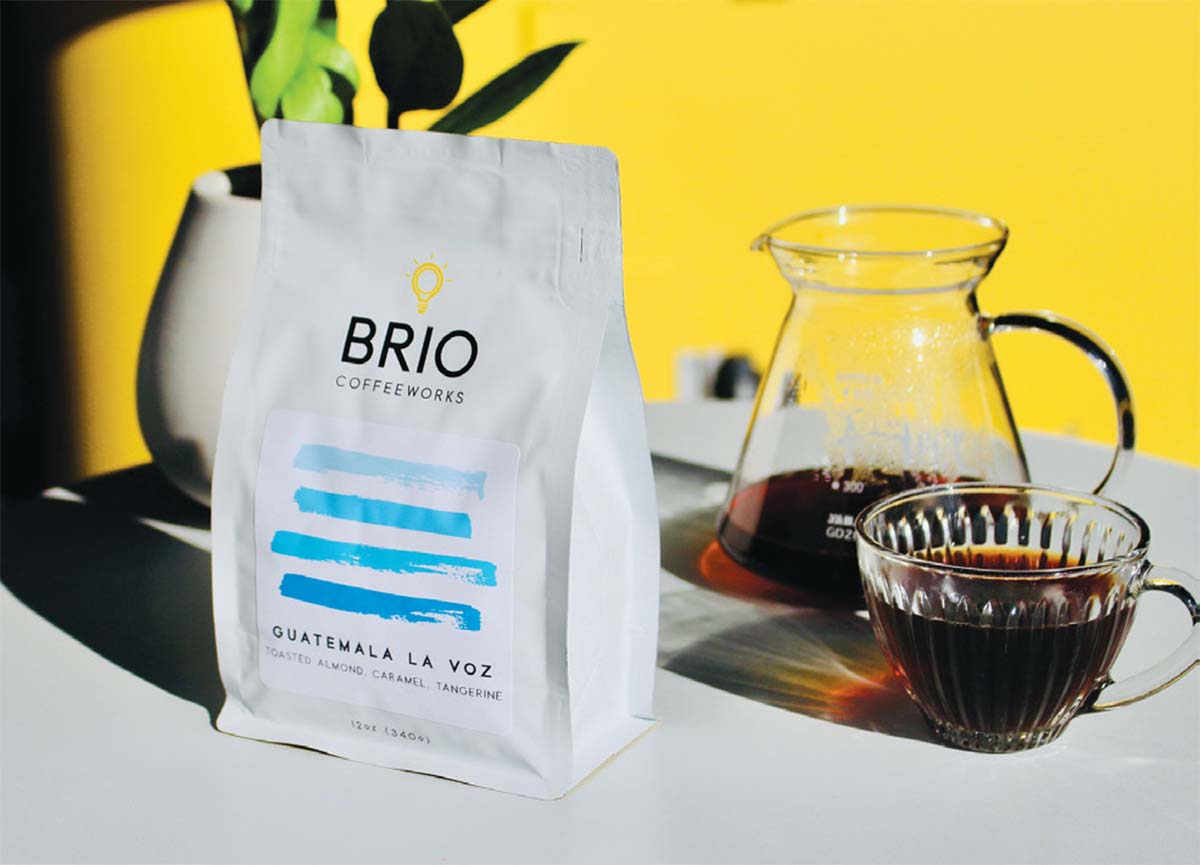BRIO COFFEEWORKS: THE GROUNDBREAKER

Enjoy a perfect cup inside Brio Coffeeworks' roastery and cafe, an airy space within The Soda Plant.
I visited Brio Coffeeworks at the tail end of a busy Saturday. The shop, which also serves as the roastery, is in Steve Conant’s The Soda Plant across from Tomgirl Kitchen and around the corner from Pitchfork Pickle. From the counter you can see giant roasters, funnels, and big bags of coffee behind shelves of coffeemaking equipment. There were three striking yellow canvases on display, part of a collaboration between Brio and up-and-coming local artists, who also design labels for Brio’s microlot and limited-release coffees.
There is a utilitarian, urban, loft-like feel to the café, which may be attributable to Nate and Magda Van Dusen’s origin story. The pair worked in Washington, DC in international development and connected to the specialty coffee scene there as consumers. Nate grew up in Vermont and, when he returned home to visit, did not see here what was happening in DC. He and Magda saw an opening and took the leap. “We were really the first roasting company in Vermont to focus exclusively on light-roast, single-origin specialty coffees,” Nate said. He admits it was a bit of a slog at the beginning and says they were in the lucky-and-unlucky position of being the first. “A lot of people didn’t really understand what we were doing, which made perfect sense. The approach was brand-new.”
When they first opened Brio, the Vermont coffee scene tended to be dominated by dark-roast coffees, which are roasted for longer, and to a higher finished temperature, than light-roasts. These higher roast temperatures produce a different set of chemical reactions in the bean—more caramelization—that yield unique flavor compounds: think roast notes of tobacco, smoke, and leather. This is all a matter of taste say Nate and Magda. It comes down to preference, and theirs is for the fruity, floral nature of light-roast coffees, with notes of honey, cane sugar, and chocolate.

Magda and Nate Van Dusen, founders of Brio Coffeeworks
Magda knew they were up for a challenge, and she says the prospect of starting something new fueled her. “We wanted to put Vermont on the map for specialty coffee in the same way the state is known for cheese and spirits and beer,” explained Magda, whose passion is rooted in connecting with customers, who, initially, were mostly wholesale accounts such as cafés, restaurants, and co-ops. “We wanted to introduce people to the unique nuances of every coffee. We brought in coffees with different flavor profiles. We put origin information and roast dates on our bags, and we talked about processing methods. This is all sort of a given now, but at the time it was new.”
Clear and open communication about their coffee products is at the root of Brio’s operation. “People are curious about where their food comes from, and it’s the same for coffee,” said Magda. “We’re always looking to introduce people to new and interesting flavors in a way that is approachable.” To this end, the company offers coffee in many forms, including freeze-dried and flash-chilled.
When I asked Nate and Magda about the name, they shared that Brio won because it was short and easy to remember. “It encompassed the energy and passion and vivacity that we wanted to convey through our coffee.” Magda and Nate want Brio to be a hub for the coffee community—at the roastery and shop, through their consumer education, professional barista education, and by being available for anyone who walks through the front door. “We want to elevate the capacity of home enthusiasts and coffee professionals to execute great coffee!”

Photo courtesy of Homer Horowitz
HOME-BREWING TIPS FROM BRIO COFFEEWORKS
Magda says that she and Nate love when folks come to the roastery to chat about their home setup. “We want to help people who are just starting out on their coffee journey and who are avid coffee enthusiasts, advising on equipment and serving as a resource.” Here are four tips from Magda and Nate for optimizing your home-brewing routine.
Get the right grind.
Magda and Nate use a burr grinder, which crushes and cuts the beans between two metal discs and yields a consistent grind. They like Barazta brand grinders. Nate says that an uneven grind, with fine, powdery particles and coarse particles mixed in, will yield a cup of coffee that can be bitter and sour. Water over-extracts the finely ground beans (bitter) and under-extracts the large bits (sour). If you can achieve an even grind size with a burr, you’ll have a cup that is sweet and balanced.
Find your favorite brewing method.
There are many options for making coffee at home. Nate and Magda tend to use an AeroPress, which Nate describes as a “really simple, hard-to-mess-up, reliable” method. He says it’s like a French press in that the water is in contact with the beans for the full brewing time, although with an AeroPress the coffee gets pushed through a paper filter for a final hit of clarification. Brio has Chemex, Kalita, and AeroPress brewing guides on their website at briocoffeeworks.com.
For French press devotees, Nate says that there is a common misunderstanding that the method requires a coarse grind. “It’s the opposite. You want a medium-fine grind, slightly finer than for a pour-over.” He said if you’re grinding your beans at the store, ignore the French press setting and go with the drip setting.
Don’t overheat your water.
Magda recommends heating your water between 195 and 205 degrees Fahrenheit. “Water that’s too hot will extract more of the bitter elements from the bean, and too-cool water can make coffee taste sour.”
Filter your water.
Nate says that if you’re on town water, run it through any filter to get out the chlorine. If you’re on well water, or water that’s hard, Magda suggests using reverse osmosis or distilled water that you can re-mineralize. She says that really hard water often results in coffee that is weak and sour tasting.




